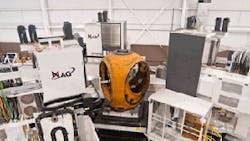Blowing Away Cycle Times
Astraeus Wind Energy's MAG MegaFlex machining system passed its initial supplier qualification when it completed "Operation 20" — a sequence of metal cutting processes — in record time on a Clipper Windpower C96 turbine hub, one of the largest such system designs in the emerging wind-power manufacturing sector. The MegaFlex machines all three blade faces simultaneously, which made it possible for Astraeus to complete the hub in less than one shift. The manufacturer declared this accomplishment “a first in the industry.”
"Completing hundreds of features on this hub in such a short time, and meeting the extreme tolerances required, is a world first for U.S. manufacturing technology," stated Astraeus president Jeff Metts. "We should be able to do the industry's simpler hubs in even less time," Metts added.
"This is, without a doubt, world-leading technology that no one else can compete with. The system is operational now and we are taking orders, forecasting a capacity of about 1,800 hubs per year," he said.
Astraeus is a Michigan manufacturing firm that MAG Industrial Automation Systems formed in partnership with Dowding Industries in 2009, to maximize the commercial impact of its expertise in large-component machining, specifically for wind-turbine systems (e.g., turbine hubs, transmissions, and main shafts.) Composite-fiber component manufacturing (e.g., for turbine blades, housings, and towers) is another priority for the initiative. As announced, the effort will be an estimated total investment of $120 million over five years, in three project phases, to develop and commercialized new manufacturing technologies for wind industry components.
The 40,000-lb (18,144-kg) spherical hub measured approximately 12 ft×12 ft (3.6×3.6 m) in size, with a blade bolt circle of about 8.2 ft (2.5 m), MAG reported. For this part, Operation 20 included milling the blade faces, drilling and tapping or counter-boring more than 60 1.5-in. (39-mm) holes per face, boring and drilling the blade-pitch gear mounting surfaces, and cutting various other features.
Tolerances on the part (which was laser inspected after machining) include 0.002-in. (0.05 mm) true position on holes and ±1 degree on angles.
Conceived by MAG in 2009, the MegaFlex development was funded in part with grants from the Michigan Economic Development Corp., which audited and approved the progress of Astraeus in meeting its performance requirements. MAG developed the entire system on a turnkey basis, including the process concept, programming, machine system production, and tooling package. The design is patent-pending.
MegaFlex is based on three MAG FTR 5000 floor-type boring mills surrounding a B-axis rotary table that simultaneously machine all three blade faces on a wind turbine hub with a single set-up. It’s a scaled-up advancement of a machining concept widely used in mass-production of automotive components and small parts.
"This is automotive machining technology scaled up an order of magnitude," stated Pete Beyer, director of product development for MAG. "We are using multiple spindles, specialized tools, and clever process technology to finish a part in one set-up, in the shortest time possible, while maintaining the flexibility to process a family of different hubs."
Concepts borrowed from the automotive industry include offline set-up and quick part-loading, using a fixture interface plate, and a lifting bracket for the workpiece. The interface plate is bolted offline to a locating feature on one side of the casting. Then, the plate mates with a locating feature on the worktable for fast part set-up. The lifting bracket attaches to the top of the part so that a single crane can transfer the part in to and out of the work zone, safely and quickly. "These are classic part-handling techniques on a gantry-type automotive line that we have adapted for very large parts," said Beyer. "We can set up the next part offline on an interface plate, and quickly exchange a completed part to maximize utilization of the spindles."
MQL, another technology adapted from automotive machining, eliminates the need to control splashing and misting coolant in the shop. "MQL is a green and sustainable technology that saved the initial and ongoing cost for pumps, filters, energy, regulatory compliance, and coolant acquisition and disposal," Beyer noted. "MQL also produces dry chips, which do not have to be cleaned or treated, but can go straight into the melting furnace."
The MAG boring mills include a specialized tooling package that uses numerous extension tools, and a servo-controlled tilting A-axis on the W-axis ram. The tilting 'A' axis allows the ram to be positioned for a normal approach angle to the work face. This is necessary because the blade face of the hub is not always perpendicular to the hub's axis of rotation, but it may be two to three degrees off, depending on the design specified by the turbine manufacturer. "The tilting ram is much stiffer than other solutions, such as a multi-axis A/C head, and it eliminates the need to interpolate axes," Beyer explained. "The tooling package allows efficient machining of the challenging features on these parts, such as the back bore on most of the bolt holes."
As part of the MegaFlex design, each machine has a latch-plate interface to accept attachments from a head changing rack. However, as a cost consideration, the system has only one attachment rack, which can be moved for use by any of the machines. Rotation of the worktable allows the machine using the attachments to access all three faces of the part. Then, synchronous/asynchronous processing is used to balance out the cutting times and cutting forces of the three spindles when doing similar and dissimilar operations.
"MAG delivered on the concept for a purpose-built system in terms of the budget, major reductions to cycle time and future flexibility," according to Metts. "Customers who have seen it say it never occurred to them to create a multi-spindle system with giant machines. When it's running, it's like watching an orchestra play.”
About the Author
Robert Brooks
Content Director
Robert Brooks has been a business-to-business reporter, writer, editor, and columnist for more than 20 years, specializing in the primary metal and basic manufacturing industries.
